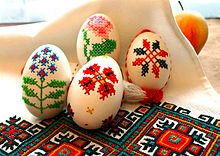EMBROIDERY

Embroidery is the craft of decorating fabric or other materials using a needle to apply thread or yarn.
Embroidery may also incorporate other materials such as pearls, beads, quills, and sequins. In modern days, embroidery is usually seen on caps, hats, coats, blankets, dress shirts, denim, dresses, stockings, and golf shirts. Embroidery is available with a wide variety of thread or yarn color.
Some of the basic techniques or stitches of the earliest embroidery are chain stitch, buttonhole or blanket stitch, running stitch, satin stitch, cross stitch. Those stitches remain the fundamental techniques of hand embroidery today.
CLASSIFICATION.
Embroidery can be classified according to what degree the design takes into account the nature of the base material and
by the relationship of stitch placement to the fabric. The main categories are free or surface embroidery, counted embroidery, and needlepoint or canvas work.
In free or surface embroidery, designs are applied without regard to the weave of the underlying fabric. Examples include crewel and traditional Chinese and Japanese embroidery.
Counted-thread embroidery patterns are created by making stitches over a predetermined number of threads in the foundation fabric. Counted-thread embroidery is more easily worked on an even-weave foundation fabric such as embroidery canvas, aida cloth, or specially woven cotton and linen fabrics . Examples include cross-stitch and some forms of blackwork embroidery.
While similar to counted thread in regards to technique, in canvas work or needlepoint, threads are stitched through a fabric mesh to create a dense pattern that completely covers the foundation fabric.Examples of canvas work include bargello and Berlin wool work.
Embroidery can also be classified by the similarity of appearance. In drawn thread work and cutwork, the foundation fabric is deformed or cut away to create holes that are then embellished with embroidery, often with thread in the same color as the foundation fabric. When created with white thread on white linen or cotton, this work is collectively referred to as whitework.[17] However, whitework can either be counted or free. Hardanger embroidery is a counted embroidery and the designs are often geometric.[18] Conversely, styles such as Broderie anglaise are similar to free embroidery, with floral or abstract designs that are not dependent on the weave of the fabric.
MATERIALS
The fabrics and yarns used in traditional embroidery vary from place to place. Wool, linen, and silk have been in use for thousands of years for both fabric and yarn. Today, embroidery thread is manufactured in cotton, rayon, and novelty yarns as well as in traditional wool, linen, and silk. Ribbon embroidery uses narrow ribbon in silk or silk/organza blend ribbon, most commonly to create floral motifs.[20]
Surface embroidery techniques such as chain stitch and couching or laid-work are the most economical of expensive yarns; couching is generally used for goldwork. Canvas work techniques, in which large amounts of yarn are buried on the back of the work, use more materials but provide a sturdier and more substantial finished textile.[21]
In both canvas work and surface embroidery an embroidery hoop or frame can be used to stretch the material and ensure even stitching tension that prevents pattern distortion. Modern canvas work tends to follow symmetrical counted stitching patterns with designs emerging from the repetition of one or just a few similar stitches in a variety of hues. In contrast, many forms of surface embroidery make use of a wide range of stitching patterns in a single piece of work.
MACHINE
Contemporary embroidery is stitched with a computerized embroidery machine using patterns digitized with embroidery software. In machine embroidery, different types of "fills" add texture and design to the finished work. Machine embroidery is used to add logos and monograms to business shirts or jackets, gifts, and team apparel as well as to decorate household linens, draperies, and decorator fabrics that mimic the elaborate hand embroidery of the past.
Machine embroidery is most typically done with rayon thread, although polyester thread can also be used. Cotton thread, on the other hand, is prone to breaking and should be avoided if under 30 wt.[23]
There has also been a development in free hand machine embroidery, new machines have been designed that allow for the user to create free-motion embroidery which has its place in textile arts, quilting, dressmaking, home furnishings and more.[24] Users can use the embroidery software to digitize the digital embroidery designs. These digitized design are then transferred to the embroidery machine with the help of a flash drive and then the embroidery machine embroiders the selected design onto the fabric.!
GALLER.jpg



